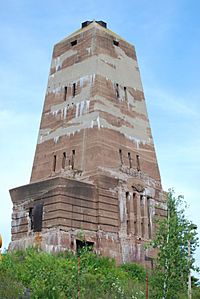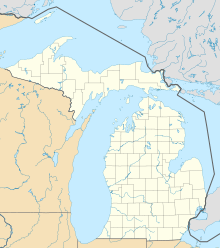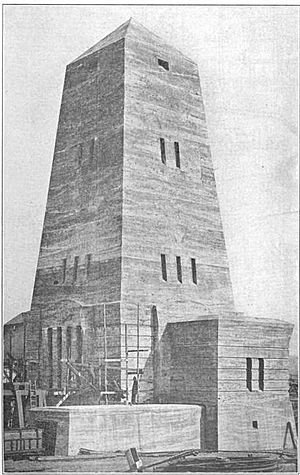Cliffs Shaft Mine Museum facts for kids

The old headframe of "B" Shaft, built 1919
|
|
| Location | |
|---|---|
| Location | Ishpeming |
| State | Michigan |
| Country | United States |
| Coordinates | 46°29′28″N 87°40′31″W / 46.49111°N 87.67528°W |
| Production | |
| Products | Iron |
| History | |
| Opened | 1868 |
| Closed | 1967 |
|
Cliffs Shaft Mine
|
|
| Built | 1880, 1919 |
| Architect | George W. Maher |
| Architectural style | Exotic Revival, Egyptian Revival |
| NRHP reference No. | 92000832 |
| Significant dates | |
| Added to NRHP | July 17, 1992 |
| Owner | |
| Company | Cleveland Cliffs |
The Cliffs Shaft Mine Museum is a cool place to visit in Ishpeming, Michigan. It used to be a big iron mine! Now, it's a museum that teaches you all about mining history. This special site became a Michigan historic spot in 1973. Later, in 1992, it was added to the National Register of Historic Places.
Contents
History of the Cliffs Shaft Mine
Early Mining Days
The Iron Cliffs Company started in 1865. A group of people from New York, including Samuel J. Tilden, created it. They bought land in Marquette County, Michigan. Their first mine, the Barnum Mine, opened in 1867. They dug two shafts, called "A" and "B." By 1870, the company had three more mine pits.
In 1877, Iron Cliffs started looking for more ore. They drilled on a site overlooking Ishpeming. They found lots of iron ore there! In 1879, they opened the Cliffs Shaft. It was first known as the "New Barnum" mine. A new boiler house and engine house were built in the early 1880s.
Changes and Growth
The mine's name changed to "Cliffs Shaft" in 1888. More big changes happened in 1891. The Iron Cliffs Company joined with other iron companies. These included the Jackson Mine and the Cleveland Mine. Together, they formed the Cleveland-Cliffs Iron Company. William G. Mather became the president of this new company.
A fire in 1901 destroyed the old dry house. A new one was built right after. The original wooden structures over the "A" and "B" shafts were replaced. Strong concrete headframes were built in 1919. A larger, more modern "C" shaft and headframe were added in 1955.
End of an Era
This mine was once the biggest producer of hematite in the nation. Hematite is a type of iron ore. It shipped ore almost every year from 1887. Mining at this site continued until 1967. This marked the end of underground iron mining in the area.
The Cliffs Shaft mine complex was added to the National Register of Historic Places in 1992. A Michigan Historical Marker also honors it. In 1998, the mine's former owners gave most of the property away. They donated it to a nonprofit group. This group wanted to create a museum there. The museum officially opened its doors in 1999.
Exploring the Cliffs Shaft Mine Site
The Cliffs Shaft site covers 15 acres above ground. It has three tall headframes. There are also eight other buildings to explore.
The Unique 1919 Headframes
The two headframes built in 1919 are very special. They are mirror images of each other. Mining engineers and a professional architect worked together on them. This was very unusual for the time.
In 1919, the old wooden headframes were getting unsafe. William G. Mather, the company president, had a great idea. He wanted the new headframes to be both useful and beautiful. This was because of their important location. The company hired George Washington Maher. He was a famous architect from Chicago. Maher designed the new headframes to look like Egyptian obelisks. This style is called Egyptian Revival architecture.
The company started building the new concrete headframes right away. They built them around the old wooden ones. The new headframes were 33 feet (10 m) square at the bottom. They tapered to 21 feet (6.4 m) square at the top. A pyramid-shaped roof made them 96 feet 9 inches (29.49 m) tall. The two structures look almost the same. They are just reversed, like a mirror image. Building continued from July to December 1919.
The 1955 Headframe
The third headframe was built in 1955. It is made of concrete with metal on the outside. This headframe was the first "Koepe Hoist" built in the Western Hemisphere.
Other Buildings on Site
The site also has several other important buildings. There's a stone boiler house and engine house from 1880. The brick dry house, built in 1901–02, is also there. You can see a laboratory from around 1917. There's also a brick blacksmith shop and the old mine office building.
Underground Tunnels
Underground, the Cliffs Shaft Mine was one of Michigan's largest iron mines. It has about 65 miles (105 km) of tunnels! These tunnels go down to depths of 1,358 feet (414 m). It is one of the best-preserved examples of underground mining in the Marquette Iron Range.
Visiting the Museum
At the museum, visitors can see many mining artifacts. There are old photographs and mining equipment. You can also explore a chemical lab and see blasting items. The engine house has a large air compressor room. Tours are often available for visitors. The museum also shows off mineral collections. These are from the Ishpeming Rock and Mineral Club.
The mine site and museum are part of the Iron Ore Heritage Trail. This is a 47-mile (76 km) bicycle and hiking trail. It covers a large part of the Marquette Iron Range. The Cliffs Shaft Mine Museum is also the starting point for the Marquette Marathon.
Images for kids
See also
- Mesabi Range
- Soudan Underground Mine State Park
- Gogebic Range
- Cuyuna Range
- Vermilion Range (Minnesota)
- Gunflint Range
- Iron Mountain Central Historic District






